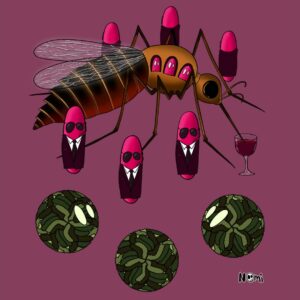Microbial communities grow everywhere and on almost any host, be it humans, plants or animals.
Some microbes come to make their hosts sick. Other microbes are there to help and protect them.
This is a story of both types of microbes and an unusual host: amphibians.
Yes, also frogs and salamanders and other amphibians carry microbes on their skins.
And some of these microbes mean to kill the animals. But, luckily, the animals are protected by helpful bacteria that produce colourful antibiotics.
Read on to find out how bacteria and fungi do not get along on the skin of amphibians. We will also explore how bacteria protect amphibians from extinction.
About fungi that infect the skins of their hosts
Many frogs, salamanders and other amphibians have gone extinct because of a deadly fungal infection. And it seems that many more animals are already infected and sick from that same pathogen.
The bad guys? The two fungal species Batrachochytrium dendrobatidis and Batrachochytrium salamandrivorans. They cause a deadly skin disease on frogs and other exotic amphibians.
Similarly, the fungus Trichophyton rubrum can infect our skin and hair. This pathogen causes a disease that you may know as ringworm or athlete’s foot. Typically, you can see such a fungal infection as a red, itchy and circular rash.
But luckily there is a new weapon around to keep these fungal intruders at bay: Bacteria that get rid of the fungus to protect their hosts.
Bacteria produce colourful antibiotics…
Few microbes can grow and thrive on the gloomy skin of frogs or salamanders. One such microbe is the bacterium Janthinobacterium lividum.

This bacterium has an interesting taste for food. It eats the released skin when the amphibians shed their skin. And it also really likes the mucus on the surface of the amphibians.
As a thank you for the good meal, the bacteria help the amphibians in the fight against the deadly fungus.
How?
Generally, bacteria produce antibiotics to get rid of annoying competitors. For example, Janthinobacterium produces the antibiotic violacein, which has a dark violet colour. This antibiotic also kills the fungi that make the frogs sick.
It is still unclear to researchers, how Janthinobacterium transports the antibiotic to the fungus. We already know that the bacterium Chromobacterium violaceum produces membrane bubbles filled with violacein. And that it throws these purple bubbles at its competitors. So, one idea is that Janthinobacterium uses a similar strategy and throws violacein bubbles at the fungus.
Also, when Janthinobacterium grows on the skin of frogs, it triggers the frog to produce more anti-fungal molecules. These molecules kill the fungus and other pathogenic bacteria that are dangerous to the frog.
… and protect them from deadly fungi
Janthinobacterium is not the only bacterium that produces colourful antibiotics to protect its host.
You might have seen red dots in your shower every once in a while. These come from the bacterium Serratia marcescens which makes a red antibiotic. Interestingly, this bacterium can also live on the skins of amphibians. And here, the red antibiotic also protects from deadly fungi.

Other bacteria, like allrounder Pseudomonas, also live on the skins of some amphibians. And these bacteria produce many different antifungals to protect their hosts.
Hence, it looks as if the right skin bacteria protect frogs and salamanders from deadly fungi. And these bacteria keep throwing around colourful bubbles filled with antibiotics – sounds like a bacterial festival to celebrate their hosts?
Colourful bacterial antibiotics to save amphibians?
Now, researchers are trying to save amphibians from the deadly fungus with a process called bioaugmentation. With this strategy, researchers introduce special bacterial communities to the environment. And they hope that the bacteria will jump over to different amphibians.
Bacteria like Janthinobacterium then hopefully establish stable communities on the skins of amphibians and protect them from fungal infections. And let’s hope that these bacterial parties will save more frog species from extinction!









